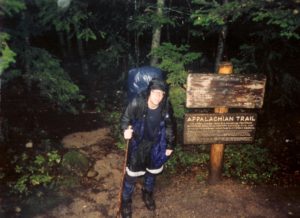(The following story ran in the Daily Item on Sept. 15, 1998)
NORTH WOODSTOCK, N.H. — As I reached the picturesque town of Hanover, N.H., last week, I stopped by the post office and picked up several cards sent by well-wishers. (Thanks, by the way.)
“The end is almost in sight!” read one.
“You’re almost there!” proclaimed another.
Well, I guess mathematically that’s true. I’ve now hiked more than 1,700 miles from Georgia and have only 400 miles left to reach Mount Katahdin.
Only 400 miles — they just happen to be 400 of the toughest, meanest miles on the entire Appalachian Trail.
That’s probably why one former thru-hiker noted that, upon reaching Hanover, you’ve done 80 percent of the miles — and 50 percent of the work.
From Hanover, the trail turns northeast and climbs sharply into the rugged White Mountain National Forest. It then winds its way over some of the highest peaks in Maine before crossing a remote expanse of central Maine known as “The 100-Mile Wilderness.”
For much of this stretch, the trail is above treeline, leaving nothing to obstruct the spectacular views on a good day, or the howling, bone-jarring winds on a bad one.
In the next few days, in fact, I’ll reach 6,200-foot Mount Washington, home of the highest surface wind speed ever recorded (231 miles an hour) and some of the most severe weather on the East Coast. One day in mid-August, the wind chill at the summit was 12 degrees, and snow fell there last week. Winds in excess of 100 mph are not uncommon.
I look forward to climbing Mount Washington, but I’m also prepared to be cautious and wait out the weather if need be. After all, my goal is to hike to Maine, not to get blown there.
I quickly learned, though, that nasty unpredictable weather in these parts isn’t isolated to Mount Washington.

Slogging through wind and cold rain near Mount Kinsman. It was some of the worst weather of the entire trip.
On my first night out of Hanover, I stopped to camp at a scenic overlook atop Smarts Mountain. I watched the sunset from atop the summit fire tower, then set out my sleeping bag under a full moon and cloudless sky.
It was a gorgeous night. Until 2:30 a.m., that is, when a thunderstorm materialized, seemingly out of nowhere.
For 15 frantic minutes, using occasional lightning flashes to light my way, I scrambled to set up my tent, cover my backpack, boots and food bag, which I had hung in a nearby tree. I then listened over the next hour as thunder rolled across the ridge and rain pelted my tent. I kept reminding myself that, six hours earlier, there hadn’t been a cloud in the sky.
Then two days later, I entered the White Mountains in earnest with a 15-mile hike down through Kinsman Notch and back up over Mount Kinsman. The hike began in fair weather, which later turned into a light drizzle. By the time I reached the summit of Kinsman, the weather had deteriorated into a driving, freezing rain bolstered by 40-mph winds. Visibility was near zero and the rain felt like pellets hitting my rain jacket as I struggled to descend from the summit and out of the wind.
“Welcome to the Whites,” I thought, where Mother Nature’s mood can change faster than you can say Franconia Notch.
Still, I didn’t hike from Georgia to give in now, so I’ve prepared myself for the best shot this trail has to offer.
I’m once again carrying cold-weather gear — I haven’t had it since mid-May — and I’ve picked up a warmer sleeping bag. The food bag also looks different, with more oatmeal, instant soup and hot chocolate.
For all their fury, though, the White Mountains can be spectacular, and many thru-hikers consider the Whites a highlight of the trail.
In fact, most southbound thru-hikers I’ve met — who have already crossed the Whites — don’t mention the weather. They mention the beauty and the splendor, the spectacular vistas and high mountain lakes, the moose and bear.
That is the trail that lies before me in the final month of this journey. To be sure, it will come with a price, namely wind, cold, grueling climbs and knee-buckling descents.
But I figure if I have 50 percent of the work left, then maybe, just maybe, I have 50 percent of the beauty left as well.